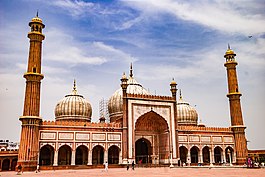| Lok Sabha Constituencies in Central Delhi district, Delhi (MP Constituencies) | Chandni Chowk |
| MLA Assembly Constituencies in Central Delhi district, Delhi | Matia Mahal |
About the District :
Central Delhi is an administrative district of the National Capital Territory of Delhi in India.
It is bounded by the Yamuna River on the east, and by the districts of North Delhi to the north, West Delhi and South West Delhi to the west, New Delhi to the south, and East Delhi to the east across the Yamuna..
Central Delhi has a population of 644,005 (2001 census), and an area of 25 square kilometres (9.7 sq mi), with a population density of 25,759 persons per km².
Central Delhi houses the central business district and highrises. It includes Shahjahanabad (Old Delhi) which served as capital of the Mughal Empire, and is home to the monuments like the Delhi Fort and the Jama Masjid, Delhi’s principal mosque.
Administratively, the district is divided into two subdivisions, Darya Ganj, & Pahar Ganj.
District at a Glance :
- District
- Headquarters –
- State –
- Total –
- Rural –
- Urban –
- Population –
- Rural –
- Urban –
- Male –
- Female –
- Sex Ratio (Females per 1000 males) –
- Density (Total, Persons per sq km) –
- Assembly
- Loksabha
- Official Website –
Tourist Places :
Red Fort :

The Red Fort is a historical fort in the city of Delhi in India. It was the main residence of the emperors of the Mughal dynasty for nearly 200 years, until 1857. It is located in the center of Delhi and houses a number of museums. In addition to accommodating the emperors and their households, it was the ceremonial and political centre of the Mughal state and the setting for events critically impacting the region.
Constructed in 1639 by the fifth Mughal Emperor Shah Jahan as the palace of his fortified capital Shahjahanabad,[3] the Red Fort is named for its massive enclosing walls of red sandstone and is adjacent to the older Salimgarh Fort, built by Islam Shah Suri in 1546. The imperial apartments consist of a row of pavilions, connected by a water channel known as the Stream of Paradise (Nahr-i-Bihisht). The fort complex is considered to represent the zenith of Mughal creativity under Shah Jahan,[citation needed] and although the palace was planned according to Islamic prototypes, each pavilion contains architectural elements typical of Mughal buildings that reflect a fusion of Timurid and Persian traditions. The Red Fort’s innovative architectural style, including its garden design, influenced later buildings and gardens in Delhi, Rajasthan, Punjab, Kashmir, Braj, Rohilkhand and elsewhere.
The fort was plundered of its artwork and jewels during Nadir Shah’s invasion of the Mughal Empire in 1747. Most of the fort’s precious marble structures were subsequently destroyed by the British following the Sepoy Mutiny of 1857.[4] The forts’s defensive walls were largely spared, and the fortress was subsequently used as a garrison. The Red Fort was also the site where the British put the last Mughal Emperor on trial before exiling him to Rangoon in 1858.
Every year on the Independence day of India (15 August), the Prime Minister hoists the Indian “tricolour flag” at the main gate of the fort and delivers a nationally-broadcast speech from its ramparts.
It was designated a UNESCO World Heritage Site in 2007 as part of the Red Fort Complex
Jama Masjid :

The Masjid-i Jahān-Numā (World-reflecting Mosque), commonly known as the Jama Masjid of Delhi, is one of the largest mosques in India.
It was built by Mughal emperor Shah Jahan between 1644 and 1656 at a cost of 1 million rupees, and was inaugurated by an imamfrom Bukhara, present-day Uzbekistan. The mosque was completed in 1656 AD with three great gates, four towers and two 40 m high minarets constructed of strips of red sandstone and white marble. The courtyard can accommodate more than 25,000 persons. There are three domes on the terrace which are surrounded by the two minarets. On the floor, a total of 899 black borders are marked for worshippers. The architectural plan of Badshahi Masjid, built by Shah Jahan’s son Aurangzeb at Lahore, Pakistan, is similar to the Jama Masjid, Delhi.
The mosque has been the site of two attacks, one in 2006 and another in 2010. During the first, two explosions occurred in the mosque, injuring thirteen people. In the second, two Taiwanese students were injured as two gunmen opened fire upon them
Latest Govt Job & Exam Updates: